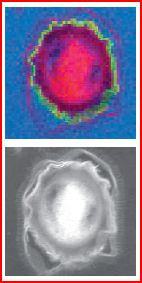Details of Silicon-Tin Chemistry of Anthrax Attack Spores Published; Willman Tut-tuts

Sandia National Laboratories image of attack spore. In the upper frame, silicon, in green, is found exclusively on the spore coat and not on the exosporium (outer pink border).
On Saturday, the Journal of Bioterrorism & Biodefense published an article (pdf) by Hugh-Jones, Rosenberg and Jacobsen that provides the details of their theory, first described in a McClatchy article, that the anthrax spores employed in the 2001 anthrax attacks were “weaponized” by a process that involved tin-catalyzed polymerization of silicon monomers. Wasting no time, David Willman was quickly trotted out in the Los Angeles Times on Sunday to tut-tut this latest information as arising from “critics” of the FBI and to provide an outlet for those who unquestioningly parrot the FBI’s conclusion from its Amerithrax investigation that Bruce Ivins acted alone in carrying out the attacks.
Shortly after the McClatchy article was published, I provided this perspective on the new revelations it contained:
The presence of silicon and how it may have gotten into the anthrax material has been a point of great controversy throughout the entire investigation. This question is important because the chemical nature of the silicon and the level at which it is present is presumed to be an indicator of whether the anthrax spores have been “weaponized” to make them suspend more readily in air so that they are more effective in getting into the small passageways of the lungs of the intended targets of the attack. Early in the investigation, Brian Ross published “leaked” information that the spores had been weaponized through addition of bentonite and that Iraq had a weaponization program that used bentonite. This report turned out to be false, as no evidence for bentonite has been found. A more sophisticated type of weaponizing would rely on mixing the spores with nanoparticles of silica (silica is the common name for the compound silicon dioxide) to make them disperse more easily.
The FBI carried out a special form electron microscopy that could identify the location of the silicon in the spores from the attack material. They found that the silicon was in a structure called the the spore coat, which is inside the most outer covering of the spore called the exosporium. If silica nanoparticles had been used to disperse the spores, these would have been found on the outside of the exosporuim (see this diary for a discussion of this point and quotes from the scientific literature) because they are too large to penetrate it. No silicon signature was seen on the outside edge of the exosporium. What is significant about the type of silicon treatment suggested in the McClatchy piece is that both high silicon and high tin measurements were found in several samples and that there is an alternative silicon treatment that would involve a tin-catalyzed polymerization of silicon-containing precursor molecules. McClatchy interviewed scientists who work with this process and they confirmed that the ratio of silicon to tin found by the FBI is in the range one would expect if such a polymerization process had been used.
What McClatchy doesn’t mention in their report is that it would seem for a polymerization process of this sort, the silicon-containing precursor molecules would be small enough to penetrate the exosporium before being polymerized, or linked together into much larger molecules, once they reached the spore coat. This would mimic the location of silicon incorporated “naturally” into spores.
As the photo above shows, the anthrax spores in the attack material had silicon that was found exclusively in the spore coat and not in the exosporium. Read more →
